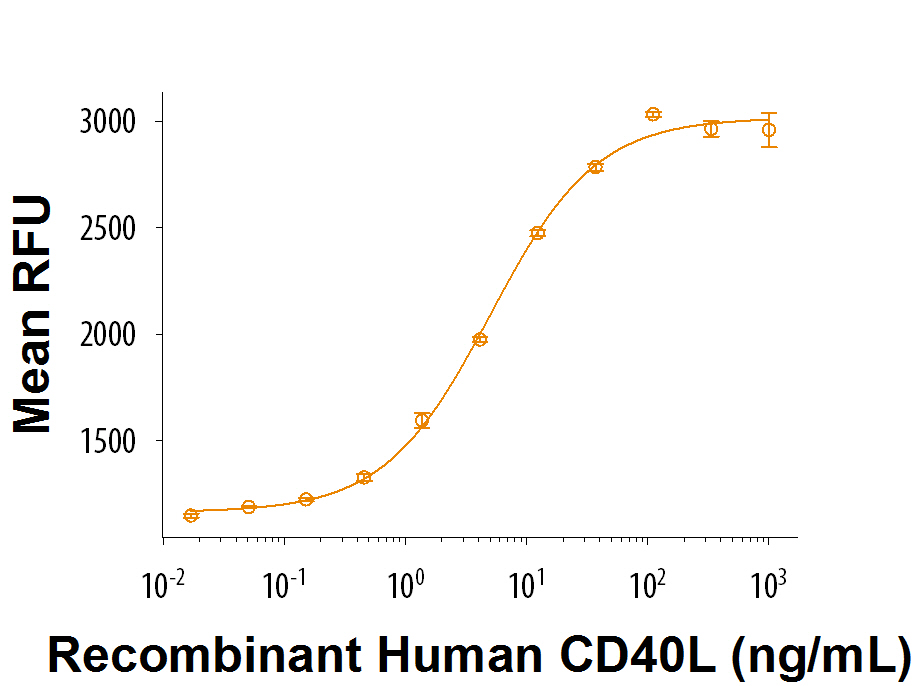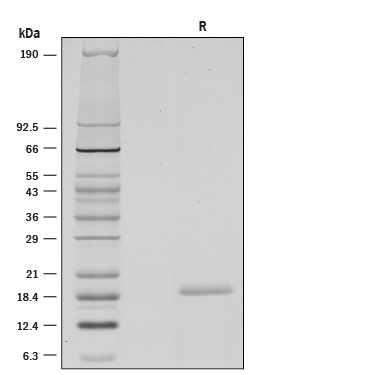Recombinant Human CD40 Ligand/TNFSF5 (Histidine-tagged)
Recombinant Human CD40 Ligand/TNFSF5 (Histidine-tagged) Summary
Product Specifications
Glu108-Leu261, with an N-terminal Met and 6-His tag
Analysis
Product Datasheets
Carrier Free
CF stands for Carrier Free (CF). We typically add Bovine Serum Albumin (BSA) as a carrier protein to our recombinant proteins. Adding a carrier protein enhances protein stability, increases shelf-life, and allows the recombinant protein to be stored at a more dilute concentration. The carrier free version does not contain BSA.
In general, we advise purchasing the recombinant protein with BSA for use in cell or tissue culture, or as an ELISA standard. In contrast, the carrier free protein is recommended for applications, in which the presence of BSA could interfere.
2706-CL
| Formulation | Lyophilized from a 0.2 μm filtered solution in HEPES, NaCl and EDTA with BSA as a carrier protein. |
| Reconstitution | Reconstitute at 100 μg/mL in sterile PBS containing at least 0.1% human or bovine serum albumin. |
| Shipping | The product is shipped at ambient temperature. Upon receipt, store it immediately at the temperature recommended below. |
| Stability & Storage: | Use a manual defrost freezer and avoid repeated freeze-thaw cycles.
|
2706-CL/CF
| Formulation | Lyophilized from a 0.2 μm filtered solution in HEPES, NaCl and EDTA. |
| Reconstitution | Reconstitute at 100 μg/mL in sterile PBS. |
| Shipping | The product is shipped at ambient temperature. Upon receipt, store it immediately at the temperature recommended below. |
| Stability & Storage: | Use a manual defrost freezer and avoid repeated freeze-thaw cycles.
|
Scientific Data
 View Larger
View Larger
Recombinant Human CD40 Ligand/TNFSF5 (Histidine-tagged) (Catalog # 2706-CL) stimulates cell proliferation using enriched B cells in the presence of IL-4. The ED50 for this effect is 2-12 ng/mL in the presence of 10 µg/mL of a cross-linking antibody, Mouse Anti-polyHistidine Monoclonal Antibody (Catalog # MAB050) and 20 ng/mL of Recombinant Human IL-4 (Catalog # 204-IL).
 View Larger
View Larger
1 μg/lane of Recombinant Human CD40 Ligand/TNFSF5 (Histidine-tagged) was resolved with SDS-PAGE under reducing (R) conditions and visualized by silver staining, showing a single band at 19 kDa.
Reconstitution Calculator
Background: CD40 Ligand/TNFSF5
CD40 Ligand, also known as TNFSF, CD154, TRAP, and gp39, is a 34-39 kDa type II transmembrane glycoprotein that belongs to the TNF superfamily (1-3). Mature human CD40 Ligand consists of a 22 amino acid (aa) cytoplasmic domain, a transmembrane segment, and an 215 aa extracellular region (4, 5). The extracellular domain of human CD40 Ligand shares 74% and 76% aa sequence identity with mouse and rat CD40 Ligand, respectively. Similar to other TNF superfamily members, CD40 Ligand forms a bioactive homotrimer, both as membrane bound and soluble forms (6-9). The 18 kDa soluble form (aa 113-261) arises from proteolytic processing. Mutation and alternative splicing generate additional forms of CD40 Ligand that are often truncated or non-trimerizable (8). CD40 Ligand is expressed on platelets, as well as on activated T cells and B cells, basophils, eosinophils, fibroblasts, mast cells, monocytes, natural killer cells, vascular endothelial cells, and smooth muscle cells. CD40 Ligand binds to CD40, which is expressed on the surface of B cells, dendritic cells, macrophages, monocytes, platelets, endothelial, and epithelial cells (10). The interaction of CD40 Ligand with CD40 initiates signaling in both CD40 and CD40 Ligand expressing cells (11). CD40 ligation by CD40 Ligand promotes B cell activation and T cell-dependent humoral responses (12, 13). CD40 Ligand dysregulation on T cells and antigen presenting cells contributes to the immune deficiency associated with HIV infection and AIDS (14, 15). It is also implicated in the pathology of multiple cardiovascular diseases including atherosclerosis, atherothrombosis, and restenosis (16, 17).
- Zhang, G. (2004) Curr. Opin. Struct. Biol. 14:154.
- Hehlgans, T. and K. Pfeffer (2005) Immunology 115:1.
- Quezada, S.A. et al. (2004) Annu. Rev. Immunol. 22:307.
- Graf, D. et al. (1992) Eur. J. Immunol. 22:3191.
- Hollenbaugh, D. et al. (1992) EMBO J. 11:4313.
- Khandekar, S.S. et al. (2001) Protein Expr. Purif. 23:301.
- Pietravalle, F. et al. (1996) J. Biol. Chem. 271:5965.
- Garber, E. et al. (1999) J. Biol. Chem. 274:33545.
- Vakkalanka, R.K. et al. (1999) Arthritis Rheum. 42:871.
- van Kooten, C. and J. Banchereau (1997) Curr. Opin. Immunol. 9:330.
- Eissner, G. et al. (2004) Cytokine Growth Factor. Rev. 15:353.
- Rickert, R.C. et al. (2011) Immunol. Rev. 244:115.
- Elgueta, R. et al. (2009) Immunol. Rev. 229:152.
- Kornbluth, R.S. (2000) J. Leukoc. Biol. 68:373.
- Chougnet, C. (2003) J. Leukoc. Biol. 74:702.
- Pamukcu, B. et al. (2011) Ann. Med. 43:331.
- Hassan, G.S. et al. (2012) Immunobiology 217:521.
Citations for Recombinant Human CD40 Ligand/TNFSF5 (Histidine-tagged)
R&D Systems personnel manually curate a database that contains references using R&D Systems products. The data collected includes not only links to publications in PubMed, but also provides information about sample types, species, and experimental conditions.
7
Citations: Showing 1 - 7
Filter your results:
Filter by:
-
Regulatory T and B cells in pediatric Henoch-Schönlein purpura: friends or foes?
Authors: Filleron, A;Cezar, R;Fila, M;Protsenko, N;Van Den Hende, K;Jeziorski, E;Occean, B;Chevallier, T;Corbeau, P;Tran, TA;
Arthritis research & therapy
Species: Human hepegivirus
Sample Types: Whole Cells
Applications: Bioassay -
B cells response directed against Cut4 and CFP21 lipolytic enzymes in active and latent tuberculosis infections
Authors: W Rénier, A Bourdin, PA Rubbo, M Peries, L Dedieu, S Bendriss, L Kremer, S Canaan, D Terru, S Godreuil, N Nagot, P Van de Per, E Tuaillon
PLoS ONE, 2018-04-30;13(4):e0196470.
Species: Human
Sample Types: Whole Cells
Applications: Bioassay -
Hypoxia favors the generation of human plasma cells
Authors: M Schoenhals, M Jourdan, A Bruyer, A Kassambara, B Klein, J Moreaux
Cell Cycle, 2017-05-02;0(0):1-14.
Species: Human
Sample Types: Whole Cells
Applications: Bioassay -
Posttranscriptional upregulation of p53 by reactive oxygen species in chronic lymphocytic leukemia
Cancer Res, 2016-09-07;0(0):.
Species: Human
Sample Types: Whole Cells
Applications: Bioassay -
The TNF-family cytokine TL1A inhibits proliferation of human activated B cells.
Authors: Cavallini C, Lovato O, Bertolaso A, Pacelli L, Zoratti E, Zanolin E, Krampera M, Zamo A, Tecchio C, Cassatella M, Pizzolo G, Scupoli M
PLoS ONE, 2013-04-02;8(4):e60136.
Species: Human
Sample Types: Whole Cells
Applications: Bioassay -
Comparison of epithelial differentiation and immune regulatory properties of mesenchymal stromal cells derived from human lung and bone marrow.
Authors: Ricciardi M, Malpeli G, Bifari F, Bassi G, Pacelli L, Nwabo Kamdje AH, Chilosi M, Krampera M
PLoS ONE, 2012-05-02;7(5):e35639.
Species: Human
Sample Types: Whole Cells
Applications: Bioassay -
Overlapping human leukocyte antigen class I/II binding peptide vaccine for the treatment of patients with stage IV melanoma: evidence of systemic immune dysfunction.
Authors: Celis E, Celis E
Cancer, 2007-07-01;110(1):203-14.
Species: Human
Sample Types: Whole Cells
Applications: Bioassay
FAQs
-
This protein datasheet indicates I need to use a cross-linking antibody, Catalog # MAB050, for biological activity. What is this antibody and is it really necessary?
The antibody is directed against a 6x histidine repeat and is recommended for use as a cross-linker of proteins with 6x his-tag. Crosslinking is often used for proteins that require receptor trimerization and can result greater biological activity. R&D Systems Quality Control tests the performance of these proteins in the presence of the cross-linking antibody. Therefore, it is necessary to use this antibody when trying to achieve the same level of specific activity described in the datasheet.
Reviews for Recombinant Human CD40 Ligand/TNFSF5 (Histidine-tagged)
Average Rating: 4 (Based on 1 Review)
Have you used Recombinant Human CD40 Ligand/TNFSF5 (Histidine-tagged)?
Submit a review and receive an Amazon gift card.
$25/€18/£15/$25CAN/¥75 Yuan/¥2500 Yen for a review with an image
$10/€7/£6/$10 CAD/¥70 Yuan/¥1110 Yen for a review without an image
Filter by:
Reason for Rating: good in our culture system can be made GMP


